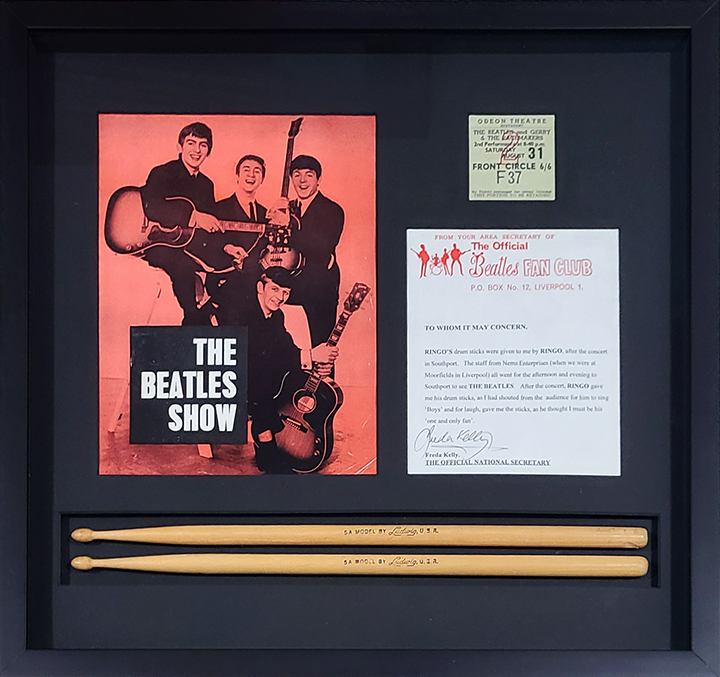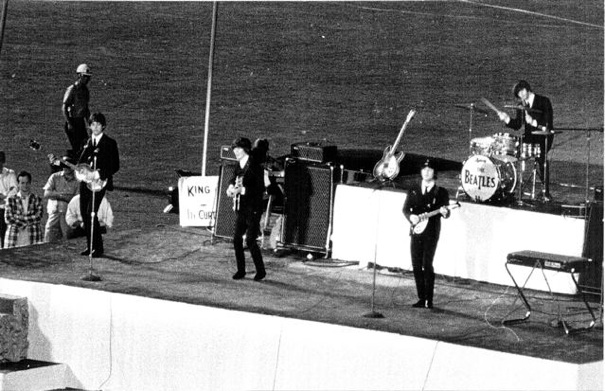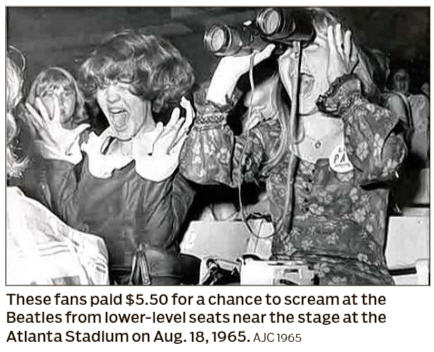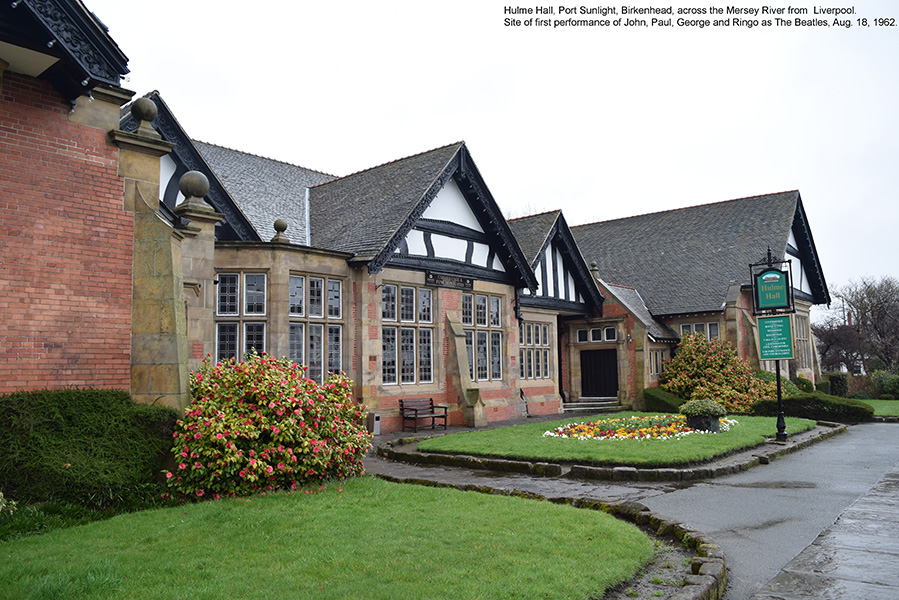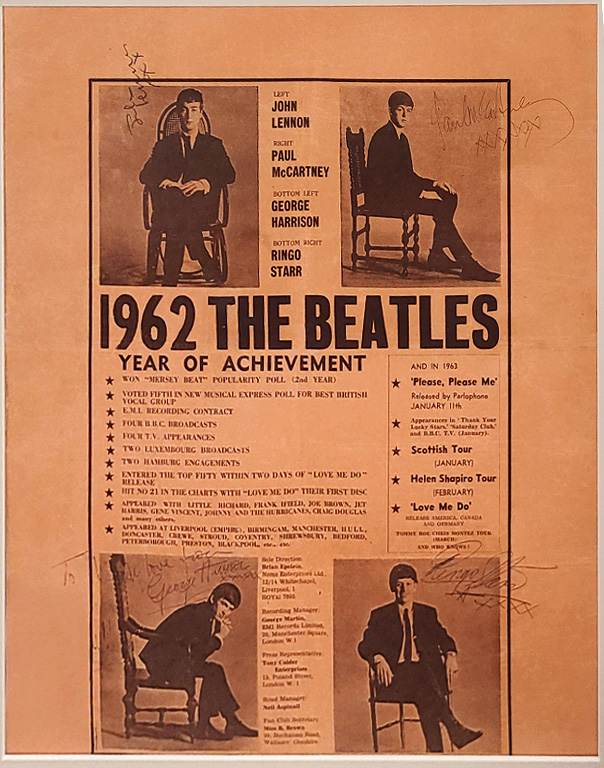Here is some information on Beatles collectibles I hope you will enjoy.
SIGNED CUTOUT FROM THE COVER OF SGT. PEPPER’S LONELY HEARTS CLUB BAND

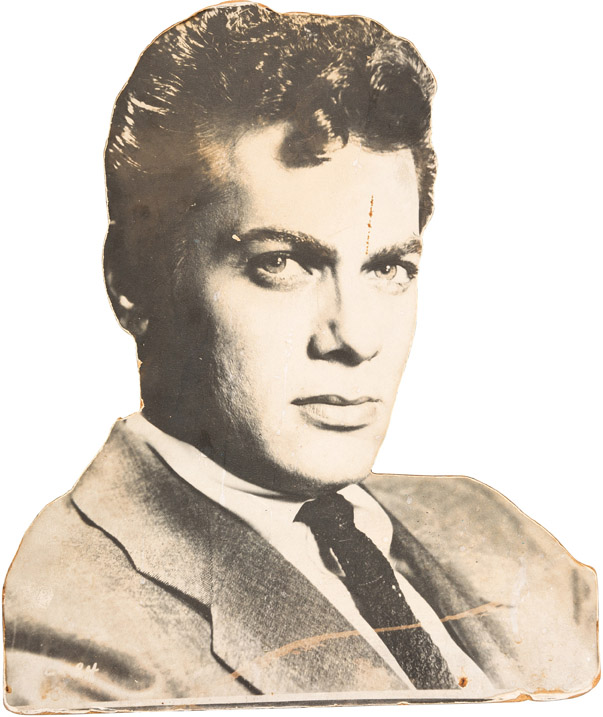
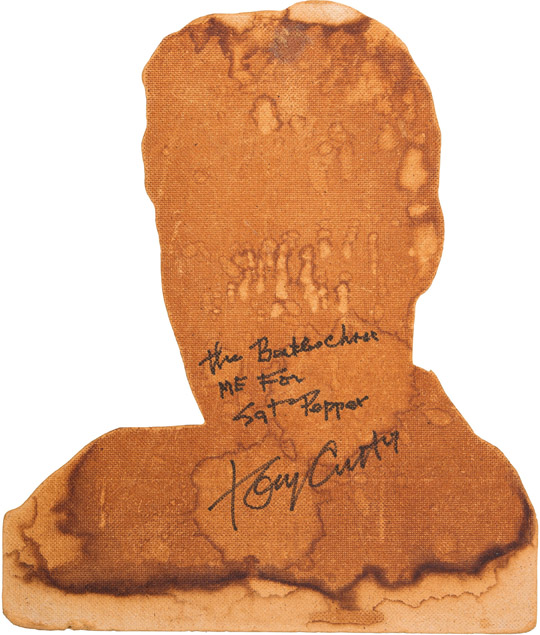
The Beatles’ Sgt. Pepper’s Lonely Hearts Club Band is arguably the most famous album cover artwork ever created. This is the actual, life-size cutout of Tony Curtis used in the album cover photograph. It appears a couple of rows above John Lennon’s right shoulder. There were 64 cutouts in the final arrangement (two were later airbrushed out), of which only 22 are known to survive, most of the others having been thrown away immediately after the photo session. This is one of only 6 owned by private collectors (the others belong to members of The Beatles, museums, restaurants and the artists who worked on the cover). Tony Curtis is the only person portrayed on the cover who autographed his own cutout. He signed on the back in 2003, “The Beatles chose ME for Sgt Pepper. Tony Curtis.”
“But,” you may say, “on the album cover Tony Curtis is a color photo, and this cutout is black and white.” All the cutouts were black and white photos, and some were hand-tinted with dyes. Unfortunately, after 50 years of exposure to light, the color has faded significantly on most of the tinted cutouts that survive. The man who actually hand-tinted most of the cutouts confirmed that there was only one of each cutout and that this is the original Tony Curtis used on the album cover. Previous owners did not know this – they believed it was an alternate cutout that was not used. The cut-outs were very expensive to create in 1967: obtaining permission from the celebrity, sourcing a suitable portrait, enlarging the image to life size, mounting to hardboard, cutting them out by hand with a saw and then hand-tinting with dyes.
It is an amazing piece of what is widely regarded as the most significant album cover artwork in history.
JOHN LENNON’S GUITAR PICK FROM ONE OF THE LAST BEATLES CONCERTS
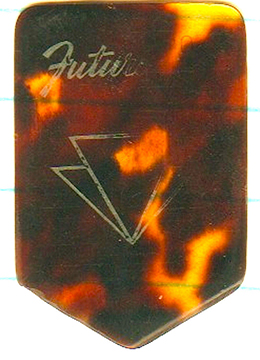
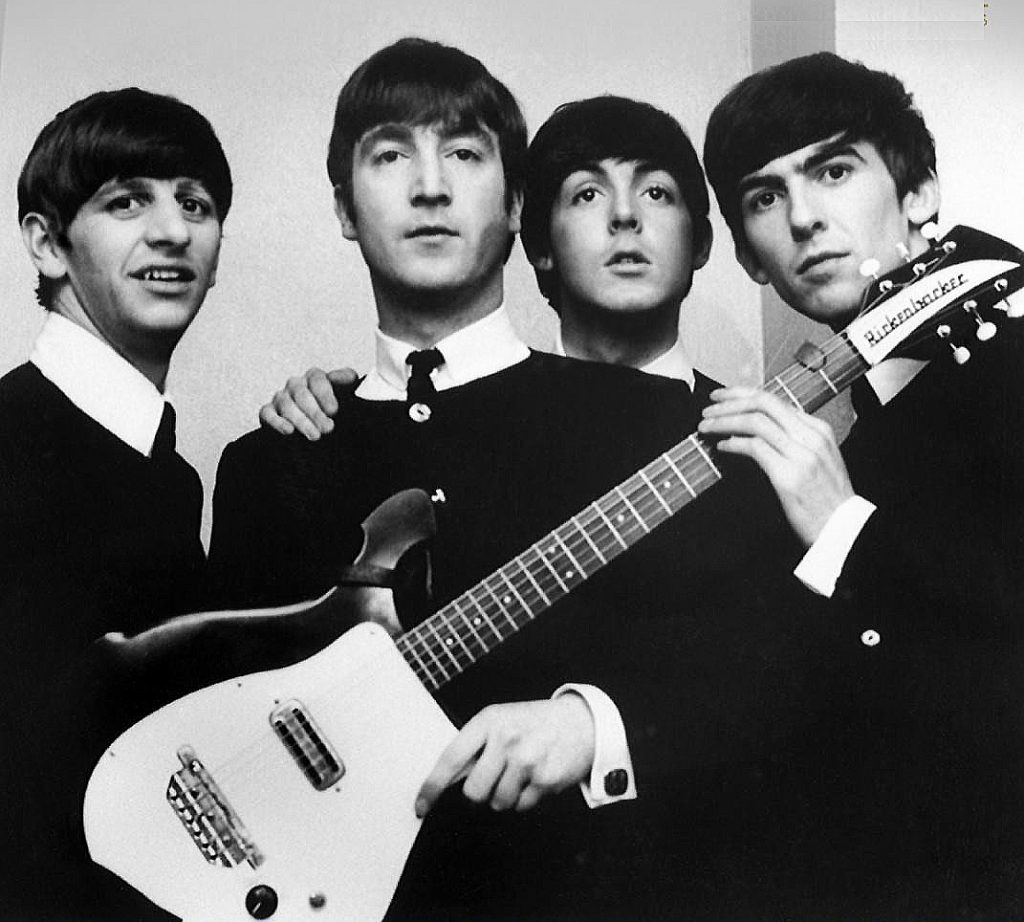
Why should we believe this was John Lennon’s guitar pick? After all, there must be hundreds of guitar picks like this. Here is a summary that convinced several Beatles experts.
First, the guitar pick itself dates to the 60’s, as confirmed by a major guitar pick collector and dealer. Second, if you are an American guitar player you will notice the shape of this pick is not one that was routinely, if ever, sold in the U.S. It was made in Czechoslovakia and imported into the UK by Selmer under the brand Futurama. (George Harrison had a Futurama guitar.) It is often referred to as a Bert Weedon-style pick, but the Selmer Futurama had less-rounded corners than the Bert Weedon made by Boosey and Hawkes. Third, extensive research reveals that this is in fact the type of guitar pick John used, though that was not easy to discover. There are few photos that clearly show the shape of the pick (none better than the photo shown above), and only two references to his picks in Beatles literature. So few people would even know this is the style of guitar pick John used.
So far it’s just a Futurama guitar pick like the one pictured on John Lennon’s guitar, but the story gets better. The man who was selling the pick is the son of The Beatles’ dry-cleaner when they stayed in Los Angeles during their last week of concerts (ever) in 1966. Every morning he and his father would go to the place the band was staying and pick up their clothes for dry cleaning. Every night, they took the clean clothes back to them. With that bit of information the story has gotten much more interesting, but we’re not there yet.
The son was 12 years old in August 1966, and a Beatles fan. Turns out he has photos of himself, taken by his mother, wearing three different sports jackets that are clearly identifiable as belonging to John Lennon. That was the clincher, but there’s more. He pulled other things from John’s pockets and still had them: chewing gum stll in the wrapper (John was notorious for chewing on stage), and two notes from a fan – one addressed to John and one to Paul – and one of them was on a 1966 high school football schedule.
The boy who emptied John’s pockets grew up to be in the music business himself. He was half the comedy recording duo Barnes & Barnes, perhaps best remembered for their hit on the Dr. Demento radio show, “Fish Heads.” His music partner was Bill Mumy, the red-headed boy in the “Lost in Space” TV show. So this wasn’t some random, unknown guy. This is an authentic John Lennon guitar pick from one of the last concerts The Beatles ever performed. It is one of very few known in a private collection with sufficient provenance.
RINGO STARR’S DRUM STICKS
The Beatles spent the week of Monday, August 26, through Saturday, August 31, 1963, performing at the Odeon Cinema in Southport, twenty miles north of Liverpool. It marked the third week in a row that the Beatles performed two shows each night. They were also filmed in a closed performance for The Mersey Beat documentary. They played the same set of ten songs throughout the residency: “Roll Over Beethoven,” “Thank You Girl,” “Chains,” “A Taste Of Honey,” “She Loves You,” “Baby It’s You,” “From Me To You,” “Boys” (Ringo’s lead vocal), “I Saw Her Standing There,” and “Twist And Shout.”
Freda Kelly was the Beatles’ secretary, president of their fan club from 1962-1972 and subject of the documentary film Good Ol’ Freda. She recalled in a letter of authenticity she wrote decades ago, and an email in December 2020, that the drum sticks “were given to me by Ringo after the concert in Southport. The staff from NEMS Enterprises (when we were at Moorfields in Liverpool) all went for the afternoon and evening to Southport to see The Beatles. I do remember that I planned to shout to Ringo for fun. It was a secret !! but somebody from the office told him what I was planning to do. When I called out for him to sing ‘Boys,’ he stood up from his drum seat and said, ‘Sit down Freda!!’ I was so embarrassed and hid down in my seat. After the concert I think he started laughing about it and gave me his drum sticks. He thought I must be his ‘one and only fan.’”
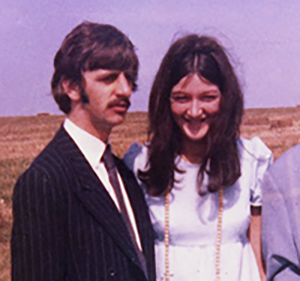
The drum sticks show some wear. It is not known how long these particular sticks were in Ringo’s stock, but they are among very few with trustworthy provenance, having been gifted by Ringo to a very good friend. Circumstances suggest that the NEMS staff probably attended the August 27, 1963, show because Brian was there that day to supervise the afternoon film session.
Stage-used Ringo Starr drum sticks from The Beatles’ touring years are very rare. Ringo only toured with The Beatles for four years, from August 18, 1962, until August 29, 1966, when the Beatles’ stopped touring. There are only three pairs of sticks known to have come on the market, one being a contest prize in 1965 by The Beatles Monthly magazine. There is some question about that pair’s authenticity because they are not the Ludwig brand Ringo was known to use most. Another pair surfaced in 2024 from the son of a concert security guard. There are three or four single sticks from various performances, making a total of perhaps ten sticks in the hands of collectors.
HANDWRITTEN LYRICS:
“MAXWELL’S SILVER HAMMER”
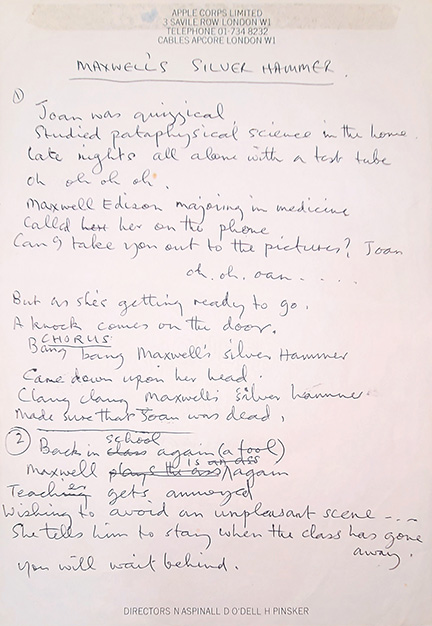
Released on the Beatles’ final album Abbey Road, “Maxwell’s Silver Hammer” was recorded July 9-11 and August 6, 1969. The band can be seen working on the song in the 2022 film Get Back, the chronicle of The Beatles’ January 1969 recording sessions by director Peter Jackson.
Handwritten lyrics show the artist at work, creating the soundtrack of our lives. In this case, it is the most successful musician of all time, Paul McCartney, writing while in the greatest band of all time, The Beatles. Frank Caiazzo, the foremost Beatles handwriting expert, has noted that “handwritten lyrics, in any form, are the absolute best piece [of Beatles handwriting] you can have.” Andy Linehan, curator of popular music recordings at the British Library, said: “Handwritten drafts of song lyrics have a special quality – they show that initial spark of creativity.” Music professor Gary Kendall instructs, “It is the only kind of hard evidence we have of how The Beatles’ creative process took place. We never think about how that song did not exist at one point. Somebody actually had to put pen to paper.”
In his 2021 book Lyrics, Paul writes about the song: “Zooming up the motorway from London to Liverpool, I fiddled around on the radio and happened on a BBC Radio 3 production of Ubu Cocu. It was broadcast on 21 December 1965, with a repeat on 10 January 1966. It’s one of three plays by the French dramatist Alfred Jarry and is subtitled ‘a pataphysical extravaganza.’ Pataphysical is a nonsense word Jarry made up to poke fun at toffee-nosed academics. I was then thrilled when I was able to rhyme ‘quizzical’ with ‘pataphysical’ in this song. I liked that people wouldn’t necessarily know what ‘pataphysical’ was, so I was being a little bit obscure on purpose.
“The thing about Maxwell is that he’s a serial killer, and his hammer isn’t an ordinary household hammer but, as I envision it, one that doctors use to hit your knee. Not made of rubber, though. Silver. Also invoked is the world of children’s nursery rhyme, where people are always getting their heads chopped off – and of course, there’s also the Queen of Hearts from Alice’s Adventures in Wonderland, who’s always saying, ‘Off with their heads!’ The Moors murderers had been jailed in 1966 for committing serial murders. That case was quite likely in my mind, as it was front page news in the UK.
“I was very keen on this song, but it took a bit long to record, and the rest of the guys were getting pissed with me. This recording period coincided with the visit to Abbey Road of Robert Moog, the inventor of the Moog synthesizer, and I was fascinated with what could be done with these new sounds. That’s one reason why it took a little longer than our normal songs. Not crazy compared to today’s standards – it was something like three days – but a long time by the standards of the day. This song is also an analogy for when something goes wrong out of the blue, as I was beginning to find happening around this time in our business dealings.”
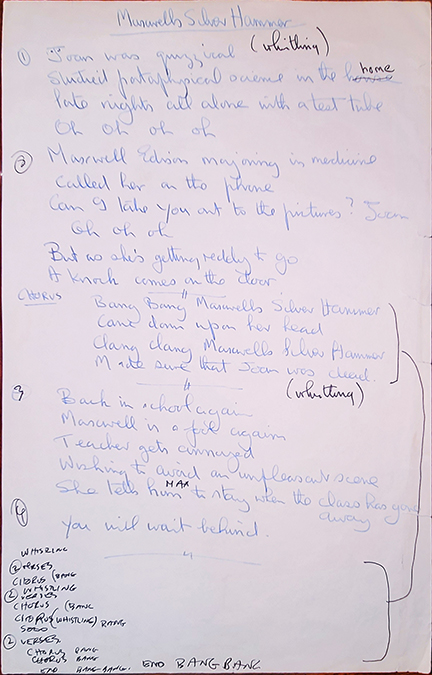
The page in Paul’s hand, on Apple Corps Limited paper, is accompanied by a draft handwritten by Mal Evans (see above). Before the proliferation of photocopying machines, lyrics would have been written out by hand for use by all those present in the recording studio. After beginning life with the Beatles as road manager, Mal Evans would later assist the band in the studio and would often be given the job of writing out the lyrics. In the Get Back film, Mal can often be seen writing down lyrics. He can also be seen “playing” the anvil, that he was tasked with finding, as this song took shape. This set in Mal’s hand is believed to appear in the Get Back film, Part 1, at 1:15:26. Mal’s notations of “whistling” and “home” in a different color ink can be seen as he holds the lyrics with one hand and strikes the anvil on cue.
AN UNUSUAL SET OF
THE BEATLES’ AUTOGRAPHS

This autograph book, containing over 400 signatures, was kept from 1958 until 1983 by an employee of the Granada Television Studios in Manchester, England. The Beatles are among many celebrities who signed the book, including Laurence Olivier, Dave Brubeck, Liza Minelli, Dizzy Gillespie, Dave Clark, Lulu, Cilla Black, Eartha Kitt, Christopher Plummer, Andy Williams, The Bay City Rollers, Twiggy, Shirley MacLaine, Natalie Wood, Joanne Woodward, Victor Borge, Britt Ekland and Larry Hagman.
What makes this set of signatures unique is not their signed names but what else they wrote in the book. The Beatles were known for their quick wit and humor, and this is an exceptionally rare written example, made on the spot for the studio employee.
The first to sign, Paul McCartney added “Epstein’s Furniture Stores” as his address – a reference to their manager’s family business in Liverpool. Brian Epstein’s family owned furniture stores, and it was through the record shop inside one of their stores that Brian first became aware of The Beatles.
Remarkably, appearing just above The Beatles’ signatures are those of British rock stars who just preceded The Beatles in fame – Cliff Richard (the “British Elvis Presley”) and Lonnie Donegan, who influenced the teenaged Lennon and McCartney. In the address field of the book, Richard had written “17 Savile.” John Lennon, not to be outdone by McCartney, added the words “Row Suit,” a reference to the fact that Savile Row in London was where the noted tailors and suit makers’ shops were located. For his own address, Lennon wrote “Pete’s Bet Shop.” More on that below.
George Harrison comically added “R.S.P.C.C. (Bolton)” as his address – the Royal Society for the Prevention of Cruelty to Children. Ringo merely added a question mark, perhaps to feign that he didn’t remember his address.
It was unusual for The Beatles to add anything to their autographs other than “Love from the Beatles” or “xxx” for kisses to female fans, or inscribing the name of a particular fan. To add humorous wisecracks to the address field of the book perfectly illustrates their personalities as exhibited in interviews and in the movie A Hard Day’s Night, which had been released just three months prior to their appearance at the Granada TV studio.
The meaning of Lennon’s quip about “Pete’s Bet Shop” was not known to me for many years after I acquired this autograph book. While sitting in an airport reading a book written by John’s best childhood friend, Pete Shotton, I came to a passage referencing the fact that about this time (late 1964) John had loaned Pete money for the purpose of opening a legal betting shop. It was a “Eureka!” moment. I immediately knew that’s what was on John’s mind when he signed this autograph.
It also bears noting that by mid-October 1964 when these autographs were signed, it had become quite difficult to get their autographs. The majority of autographs were signed in 1963 when they were still playing small halls and theaters in England.

A RARE BEATLES STAGE SET LIST
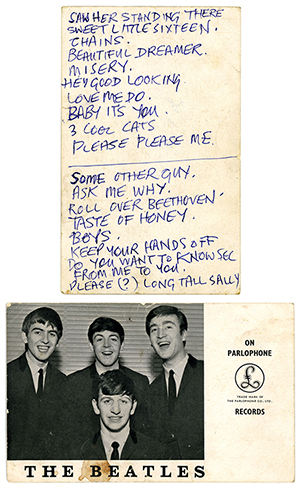
This is a very rare set list written by Paul McCartney for The Beatles’ concert at the Azena Ballroom, Sheffield, England, April 2nd, 1963. “THE” Beatles were John, Paul, George & Ringo. Starting from Ringo joining the band in 1962, there are only nine set lists written by a Beatle known to exist in private collections outside those still owned by a Beatle or their Estates. Of those nine, this list of twenty songs performed that night is the longest. By 1963, their average show was only 10 or 11 songs, due in part to the fact that they were usually part of a multi-act lineup, sometimes five or more entertainers on a bill.
This set list includes 13 songs recorded by the band, and 9 of 14 from their debut album. It also includes a few songs from their earlier days that would soon disappear from their performances forever. The Beatles’ concerts in 1964-66 were typically the same from show to show on each tour, having time only to do their hits. That also limited the need to create set lists, making them all the more rare. This set list is on the back of a Parlophone Records postcard, which is somewhat rare itself.
Below is a photograph of The Beatles at the Azena Ballroom on the night they used this set list.

A RARE, SIGNED BEATLES SET LIST
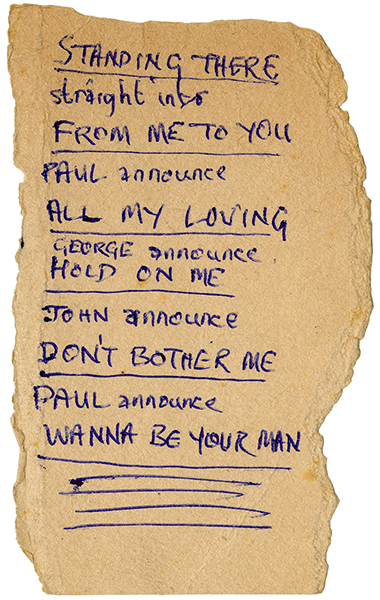
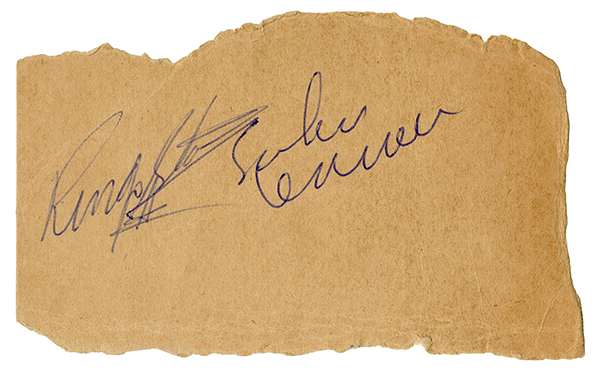
This set list was obtained by a 17-year-old girl the day after the Beatles’ 1 November 1963 concert in Cheltenham, England. She encountered John Lennon and Ringo Starr getting into a limousine and asked for their autographs. Having nothing with her for them to sign, Ringo pulled this set list out of his pocket, signed the back and handed it to John who also signed.
It is an unusual set list, one of only two known to exist with an indication which Beatle would introduce each song to the audience. (The only other such set list is presumed to still be in the possession of Paul McCartney.) It is also one of only four known surviving set lists to be autographed by The Beatles, but in this case two Beatles.
The set list shows a marked change in The Beatles’ repertoire. Previous shows featured songs from their first album, Please Please Me, and familiar cover tunes. Having just finished writing and recording their second album, With The Beatles, the new songs were featured along with their previous hits.
The set list from this night, handwritten by Paul McCartney on a scrap of paper, is inconsistent with some known facts about the concert. It lists “Don’t Bother Me,” George Harrison’s first composition which had just been recorded for the new album. It is believed that that song was never performed live by The Beatles, and the popular Chuck Berry tune “Roll Over Beethoven” was substituted, possibly at the last minute, because George had performed that song many times. In a similar vein, until this tour Ringo usually sang “Boys,” but his song on the new album was “I Wanna Be Your Man.” Paul thought Ringo should sing the new tune, but apparently Ringo demurred to his tried-and-true “Boys” after Paul wrote out this set list. The Rolling Stones had released their version of “I Wanna Be Your Man” on this very day. Perhaps The Beatles decided they didn’t want to do a “Stones song,” even though it was a Lennon-McCartney composition. Or, perhaps they were not quite ready to perform those two new songs. We’ll never know why they didn’t follow this set list that night.
The list consists of only six songs although they played ten that night. This can be explained by the fact that the list was in Ringo’s possession. In preparing for the new tour in support of their new album, Paul may have written out this set list specifically for Ringo’s use, so he could anticipate when to position his microphone and be ready to sing his one song for the night. (By this this time, the girls’ screams may have necessitated having a set list for this early stop on the new tour.) This hypothesis is supported by Paul’s underlining Ringo’s song five times – something he would not typically do for anyone else’s use. With the likely last-minute changes to the set, Ringo probably just left this in his pocket until the next day.
There is one other possibility – it could be a set list from a different concert, and Ringo still had it in his coat pocket the day he gave it to the fan. That is unlikely, however, given the date it was acquired.
Another interesting thing about the Cheltenham show is that the local paper the next day may have been the first to use the new word “Beatlemania” in a publication, to describe the fans at the Cheltenham concert. The photos below show The Beatles in Cheltenham, and the newspaper review.
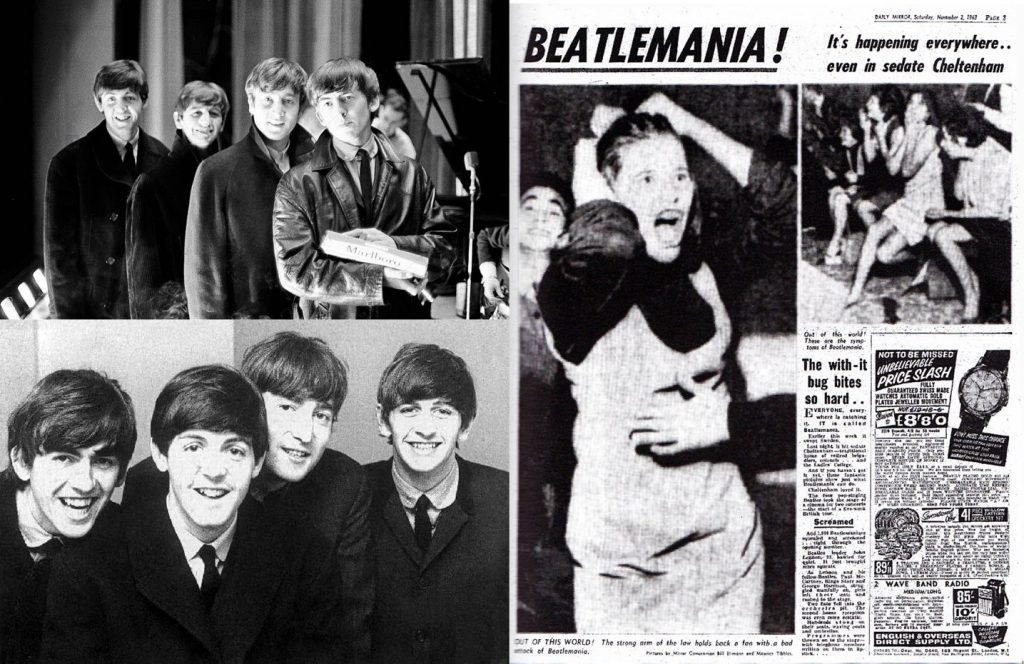
PERFORMANCE CONTRACT FOR A 1965 BEATLES SHOW, SIGNED BY BRIAN EPSTEIN
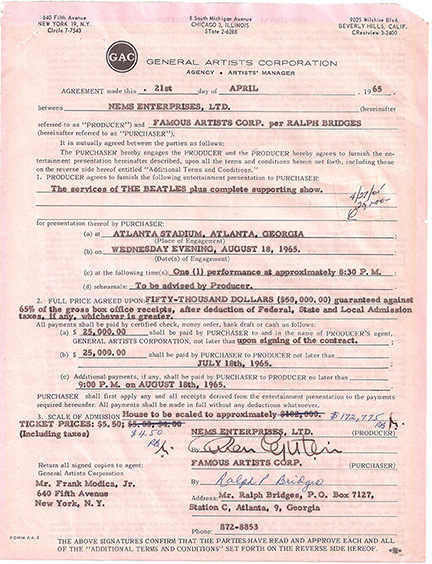
Ever wonder what The Beatles were paid for a concert at the peak of their popularity? This contract, signed by The Beatles’ manager Brian Epstein, shows they were guaranteed $50,000 against 65% of the gross box office receipts. The August 18, 1965, concert was at Atlanta Stadium.
The 3-page rider which is attached to the contract contains many interesting requirements and conditions, the most talked about being that The Beatles “will not be required to perform before a segregated audience.” It had become an issue in 1964 for the dates in the South. The Beatles refused to go on stage in Jacksonville, Florida, until the segregated audience was allowed to merge. It was their first public political stance, and it resulted in the clause being added to all their contracts.
Of the 46 stops on The Beatles’ three US tours, approximately 32 of the contracts still survive. As of this writing, 23 of them are in one collection, so owning an original Beatles contract is not easy.
ONE OF THE FIRST SETS OF
AUTOGRAPHS BY THE BEATLES

The Beatles are widely known as John, Paul, George and Ringo. The original band members, however, were John Lennon, Paul McCartney, George Harrison, Stuart Sutcliffe and Pete Best.
Though lesser known, Stuart and Pete were critical players in the history of The Beatles. John, Paul and George formed a band called the Quarry Men in early 1958, all three playing guitars. On January 21, 1960, Lennon convinced his friend Stuart to spend his art contest prize money on a bass guitar and join the band. When the band changed their name a couple of months later, Stuart came up with “The Beatals,” John changing the spelling. The name went through several iterations, including the Silver Beats and the Silver Beatles.
In August 1960 they were offered a gig as the house band in a club in Hamburg, Germany. Required to have a drummer, Pete Best joined and not only saved the gig from going to another band, but may have kept the band from dissolving. Dropping “Silver” from their name, they were simply “The Beatles” for the first time. They developed their world-conquering style over the course of 1100 hours on stage in Hamburg between August 17, 1960, and the end of 1961.
Not only had Stuart provided the band’s name, he was influential in changing their appearance. John, Paul and George got rid of their 1950’s-era Brylcreemed hair style, adopting Stuart’s new combed-forward style that the media would soon refer to derisively as a mop top. When manager Brian Epstein wanted them to wear suits on stage, they opted for the collarless jacket design they had seen Stuart wear.
Stuart, a gifted artist, left the band on July 1, 1961, to paint full time. Tragically, he died eight months later at the age of only 21. Paul was left to take over on bass guitar, for which he became legendary. Pete stayed with the band for two years until The Beatles made their last personnel change, replacing him with Ringo Starr on August 16, 1962. But it was with Pete and Stuart that John, Paul and George developed into an exceptional band.
This piece of lined paper was signed by the original Beatles during the first few months of 1961, likely in Liverpool. The original five were together for only 10 ½ months, a time that is often referred to as “pre-fame” when very few fans were asking for their signatures. Consequently, only four sets of all five autographs signed for a fan are known to exist (thirteen signed payroll documents from the Top Ten club in Hamburg also exist). Complete sets of autographs signed by The Beatles are among the most highly sought-after autographs in the world. This particular set had not been on the market in thirty years. One of the few complete sets of autographs of the original five Beatles is truly a collector’s grail.
1961 PAY RECEIPT SIGNED BY
THE ORIGINAL 5 BEATLES
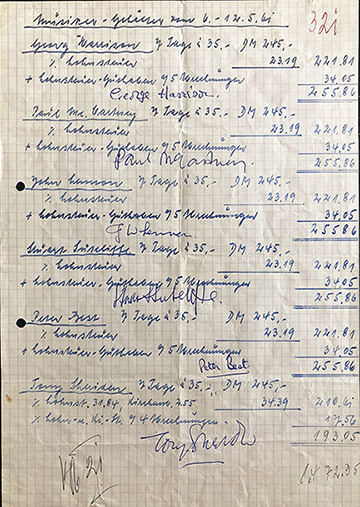
The Beatles played for thirteen weeks at the Top Ten Club in Hamburg, Germany in 1961. At the end of each week, they went to the office to collect their pay and signed a receipt. This is one of those 13 receipts signed by John, Paul, George, Stuart and Pete. During this club residency, they also spent some time backing singer Tony Sheridan, and even made their first professional recordings with Tony, who also signed for his wages on this receipt.
The Beatles were required to work fifty-one hours per week – from 7pm until 2am each weekday, and from 8pm until 4am on weekends. Mark Lewisohn: “Thirteen weeks at the Top Ten Club, playing a staggering total of 503 hours on stage over 92 nights. It was little wonder then that their stamina and musical versatility improved dramatically. When they returned to Liverpool in July, they were simply untouchable.”
A friend asked recently if I could attend any concert in history, which would it be? I said a show by The Beatles at the Top Ten Club in Hamburg. Those shows were at the peak of their stage performances (as admitted by John Lennon), and before their shows became 15-30 minutes per night. The club performances before they were famous were very different than any of the films you have seen. Can you imagine watching their wild stage show for four hours in one night?
ABBEY ROAD STREET SIGNS
If you have gotten this far reading about Beatles collectibles, you are probably a big enough fan to know that they recorded in London’s EMI Studios on Abbey Road, probably the most famous street in London (quick – name another one). Most people have seen the now-iconic image of the Abbey Road street signs that looks like the one in the photo below:
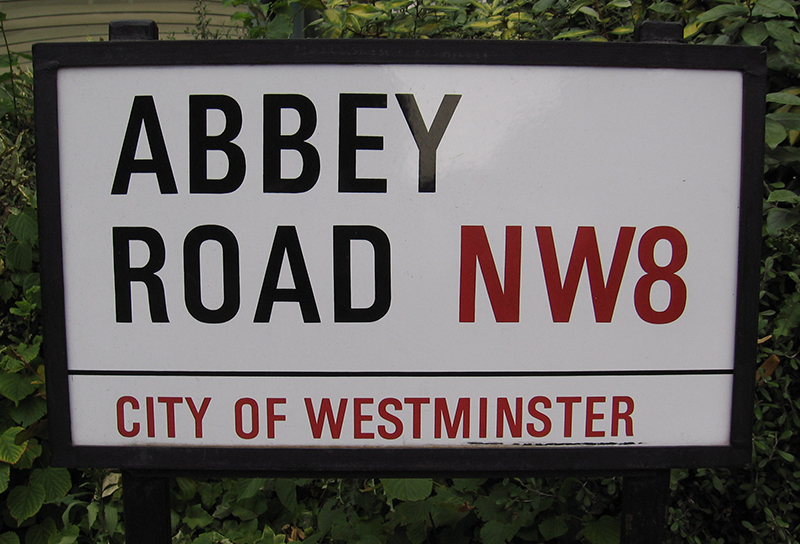
These are metal, embossed signs that varied in size depending on where they were placed. Some were in metal frames anchored in sidewalks, some were mounted high on building walls, etc. They were stolen from Abbey Road so many times that the City of Westminster stopped replacing them (I didn’t do it!). I believe the only ones still on the road that look like this are the ones mounted on the second floor of buildings.
What most people do not know is that for most, if not all, of the time that The Beatles were actually recording on Abbey Road, the street signs looked like this:

The Marylebone signs were in place from at least the 1950’s until 1969 when they were replaced with the Westminster signs due to a change in city government in 1965 (it took a while for the new city to get around to replacing hundreds of expensive signs throughout the city). Both styles are genuine Abbey Road signs, but in my opinion the Marylebone signs are much more appropriate as a Beatles-related item. Only about half a dozen Marylebone signs have appeared on the market in the past 30 years.
RARE “BRITISH INVASION” AUTOGRAPHS
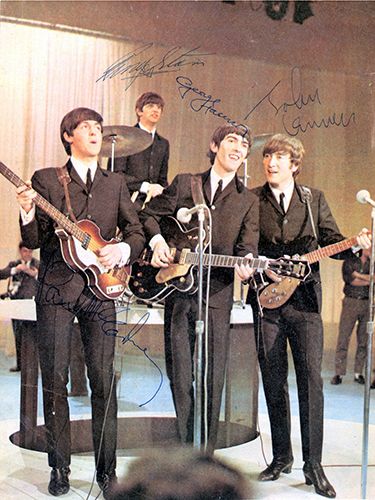
This is the only known signed image of The Beatles on the Ed Sullivan Show stage on February 9, 1964. A then-record 74 million Americans (almost 40% of the population and 60% of all TV viewers) watched as The Beatles made their live debut to American audiences. It was arguably the most important music ever broadcast on American television.
The signed photograph is also unusual due to it’s large size (almost 14 x 11), that it is in color and shows the group in a performance pose. All of these aspects make it a unique set of The Beatles’ autographs. The photo was taken immediately prior to the show during the press corps’ limited time with the group. The photo below was taken at nearly the same instant by another photographer. You can see the man at the front of the stage riser taking the photo that was later signed by The Beatles.
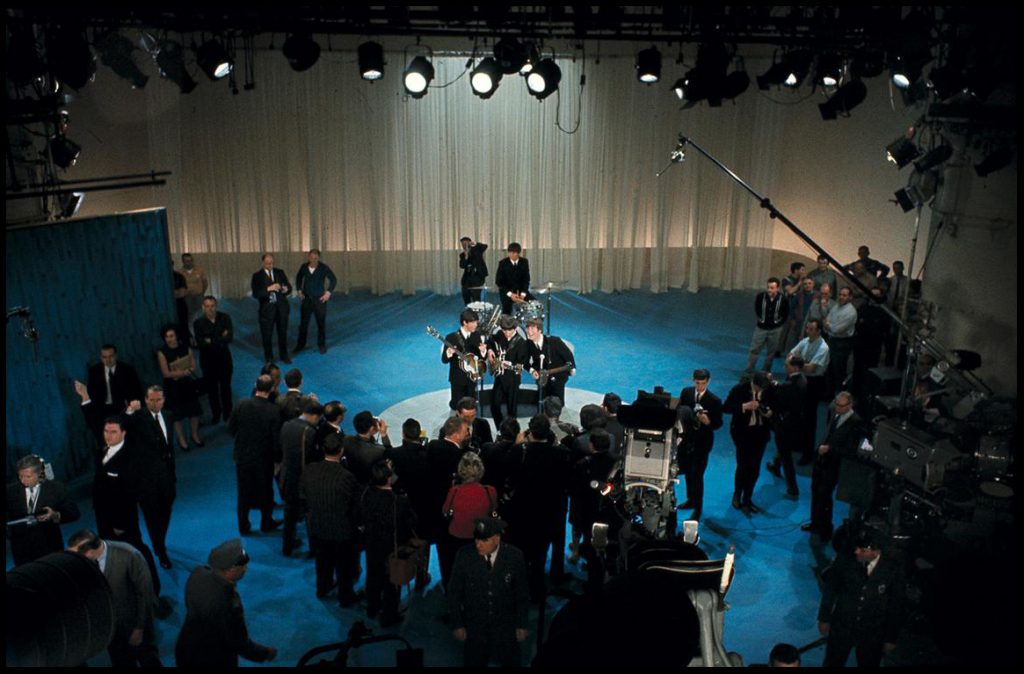
The photo was advertised as having been taken on February 8 during rehearsal, but research proved that the photo was in fact taken right before the show on the 9th, a more historically important date.
Of course, the photo taken on February 9th wasn’t signed that same day. The autographs were obtained at the Hotel St. George, Wellington, New Zealand, between 21 and 23 June 1964, where the group stayed during performances at the Town Hall. The piece is accompanied by a letter on Hotel St. George letterhead from the recipient of the autographs, likely a hotel employee, which reads:
“Dear Shirley, Thanks for your letter and I’m pleased that the family were thrilled with the autographs of the Beatles. A few comments about them: They were skinny in physic – pale in complexion and of course very noticeable with their mops of hair. … It was not the Beatles that created the confusion but the local teenage population – as we all know. While staying here, the only time they left the hotel was to move to the Town Hall for their two shows a night. They slept to 4 o’clock in the afternoon and had a breakfast of cornflakes, fruit, juice and bacon and eggs, coffee. The next meal was after the show this was usually soup, salad, chicken or steak and fruit. So, only two meals a day. There were 15 people in the party including 5 managers who were good customers of the bar. When the Beatles arrived back in the hotel they always seemed very pleased that they had managed to pass through the crowd without losing an arm or ear. That I suppose is only natural for anyone as the crowd are pretty boisterous. When they first arrived at the hotel, it was impossible for the crowd to be controlled by the police and the result was that they came through the bottle store entrance before anyone realised what was happening apart from 50 policemen. They then got stuck in the lift and it was not for about 5 minutes before they were released. The language was very Liverpool in this instance. Their lives are unusual as all they do is to live in hotel rooms and theatres and nowhere else. Ringo appeared to do all the talking and so much for the Beatles.”
SIGNED PLEASE PLEASE ME ALBUM
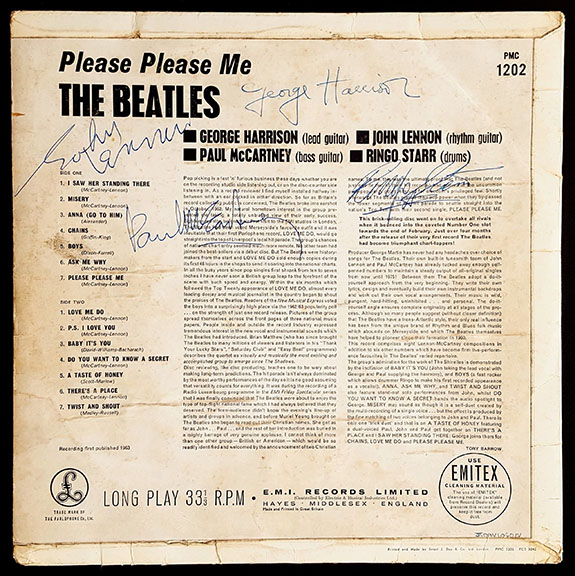
Foremost Beatles handwriting and signature expert Frank Caiazzo: “As one of the most desirable pieces of Beatles signed memorabilia, signed album covers are indeed very highly sought after. They are extremely rare, in part because of their size and general lack of portability. Most autograph seekers did not choose to bring them or they simply didn’t have them readily available when encountering The Beatles in person. Signed LP’s are desirable because in a very real sense, it is akin to an artist signing and acknowledging their work. All in all, owning an album cover signed by The Beatles is a privilege about which very few can boast and without question, the ultimate in any true fan’s collecting experience.
“Please Please Me, a seminal album in early ‘60s British rock, was rush-released on March 22, 1963, [and it] thrust The Beatles into the national spotlight in Great Britain. It immediately exploded onto the British charts and went to Number 1 where it remained for 30 weeks, until it was replaced at the top spot by the band’s follow up album, With The Beatles.
“Please Please Me was released in the Spring of 1963. However, with each passing month it became increasingly more difficult to come face to face with them. By the end of the year it was next to impossible, as their phenomenal success put considerable distance between the group and their fans. This is a nice vintage-signed copy of The Beatles’ debut album — the one that started it all for the most influential band in the history of popular music.”
TICKETS TO THE MOST IMPORTANT BEATLES PERFORMANCES
Shown below on this page are tickets or ticket stubs for, in one opinion, the most important concerts of the approximately 1,500 performances The Beatles gave, arranged by date. It started as a top ten list, and has been slightly expanded to thirteen. The list:
- 1960-8-17 to 1962-12-31, Hamburg, Germany. It is often said, “No Hamburg, no Beatles.” The Beatles were not a good band, and probably on the verge of breaking up until they landed a gig in Hamburg, Germany. They played approximately 1100 hours in four clubs, and by the end of their time in Hamburg, Ringo had joined the band. The first two clubs, the Indra and Kaiserkeller, never had admission tickets. The Top Ten Club and the Star Club issued tickets, but very few exist today.
- 1960-12-27 Litherland Town Hall, Liverpool. Upon returning to Liverpool, the band was exhausted and pretty much unknown in their own hometown. Cleverly billed as “Direct from Hamburg” at Litherland Town Hall, the audience thought it was a German band. Their performance, honed to a sharp edge in Hamburg, caused the dancers to stop and crowd in front of the stage. This was the night The Beatles took Liverpool by storm and started their dominance of the local music scene. As of this writing, the largest dealer of Beatles memorabilia in the UK has said he is not aware of any tickets or stubs existing from this show, if in fact any were printed. The advertisement for the show stated 3 shillings – “pay at the door,” so maybe there were no printed tickets. Some fakes have been on the market.
- 1961-11-9 Cavern Club, Liverpool. By this time, the Beatles had been back to Hamburg for several weeks-long stints. On one trip they recorded for the first time, backing singer Tony Sheridan. A Liverpool lad asked for the record at Brian Epstein’s record shop. Brian went to see them at the now famous Cavern Club, and within days asked to manage the band. Without Brian as manager, The Beatles would almost certainly not have become “bigger than Elvis” as he predicted. There are no tickets known to exist from this show, but 1961 Cavern Club Membership booklets served as tickets for the serendipitous night The Beatles unknowingly impressed their soon-to-be manager and star maker.
- 1961-12-27 Cavern Club, Liverpool. The Beatles were quite familiar with Rory Storm and the Hurricanes’ drummer Ringo Starr, the bands having played the same venues many times. On this very cold Liverpool winter evening, The Beatles’ drummer Pete Best called in sick. Fortunately, the Hurricanes had the night off and Ringo was deputized to sit in, making this Ringo’s first paid gig with The Beatles. He would not become a permanent member until eight months later…
- 1962-08-18 Hulme Hall, Port Sunlight. In my opinion, this is the most historic performance of The Beatles because it is the first with Ringo Starr as the fourth and final member of what became known as the Fab Four – the most successful band in history.
- 1963-10-13 London Palladium. In 1963, the London Palladium was arguably the most famous theatre in the world. If you performed at the Palladium, you had “made it.” The Beatles’ popularity had been growing steadily and to increasingly frantic heights throughout 1963, but their appearance at the London Palladium on Sunday 13 October catapulted them from teen fanzines into the mainstream media. The televised show was witnessed by 15 million people, and “Beatlemania” began.
- 1963-11-4 Royal Variety Performance, Prince of Wales Theatre, London. In the presence of Her Majesty Queen Elizabeth the Queen Mother and Princess Margaret, John Lennon made one of the most famous stage quips in music history with his rebellious introduction to “Twist and Shout.” “For our last number I’d like to ask your help. The people in the cheaper seats clap your hands. And the rest of you, if you’d just rattle your jewelry.” The TV broadcast had an audience of 21 million, and the band’s persona as cheeky, rebellious pop stars was cemented.
- 1964-2-9 The Ed Sullivan Show, New York. Viewed by a record 73.7 million people (40% of the entire US population), simply put this was the most important televised music performance in history. It was the launch of the British Invasion in American music and culture.
- 1964-2-11 Washington, D.C. The first public concert in America. No other explanation necessary.
- 1965-8-15 Shea Stadium, New York. The first ever pop/rock music stadium show, before 55,600 screaming fans. The attendance record was not broken until several years later.
- 1966-8-29 Candlestick Park, San Francisco. The last ticketed concert by The Beatles.
- The 1964 and 1965 Hollywood Bowl shows, Los Angeles. Some say they were The Beatle’s first live concert recordings to be released, though it was not until 1977. The Washington D.C. concert in February 1964 was actually the first full live concert recording, released to theaters that spring, and on DVD many years later.
- 1969-1-30 at 3 Savile Row, London. The “rooftop” performance on their office building could not be seen or attended by the public, thus no tickets. It was the last time The Beatles performed a live set that the public passersby below could hear (sort of).
Hamburg Germany Tickets

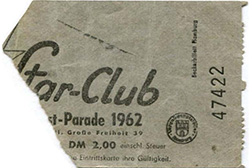
In August 1960, probably on the verge of breaking up, The Beatles were hired as the house band for a bar in Hamburg, Germany. After several other groups declined to leave Liverpool for Hamburg, Allan Williams gave The Beatles the job. He had not even considered them a real band since they didn’t have a drummer, they weren’t very good, and their repertoire was limited. But after five residencies in four venues, and 1,100 hours on stage in Hamburg, by the end of 1962 they were prepared to conquer the world. It is often rightly said, “No Hamburg, no Beatles.” Liverpool may have birthed The Beatles, but Hamburg was their training ground.
The two 1960 residencies in Hamburg were at the Indra and Kaiserkeller bars. The Beatles’ job was to entice people in off the street. There were no tickets printed by these bars.
In 1961, the Beatles advanced to a better venue, the Top Ten Club. The tickets were generic, not displaying band names or dates, and torn off a roll of perforated tickets. Author Thorsten Knublauch, the foremost expert on The Beatles in Hamburg, states that he has seen only eight Top Ten Club tickets on the market in his 35 years of collecting. While it is very possible this generic ticket was used for a Beatles show (considering their popularity and that someone bothered to save the stub), it cannot be conclusively established. In any event, the tickets were identical for the Beatles’ shows, and it is an extremely rare early 1960’s souvenir from the club that was an important stepping stone in the group’s career.
In 1962, The Beatles were the inaugural house band for the new Star Club, the best club in the district. As with the Top Ten, the entry tickets were generic. The original club logo included a six-pointed star, but it was too similar to a magazine’s logo, so the star was changed to five-points. The six-pointed star was cut off the existing tickets, like this one, during December 1962. The Beatles played fourteen nights that month. By then, Ringo had replaced Pete on drums. Knublauch has seen only fourteen Star Club tickets from 1962 on the market.
The performances at the Top Ten Club and Star Club are among those at the very peak of The Beatles’ stage shows. For a ticket costing about $4, they performed seven to eight hours per night. When they returned to England in 1963, Beatlemania quickly took hold, the fans’ deafening screams obscured the sound of the group’s 20- to 30-minute performances (occasionally an hour), their set list reduced to only a few hits. Also, The Beatles’ stage antics were considerably more restrained after Hamburg.
To see The Beatles at the peak of their diverse repertoire and energetic stage performances, one needed a ticket like these.
1st U.S. CONCERT AUTOGRAPHS & TICKET
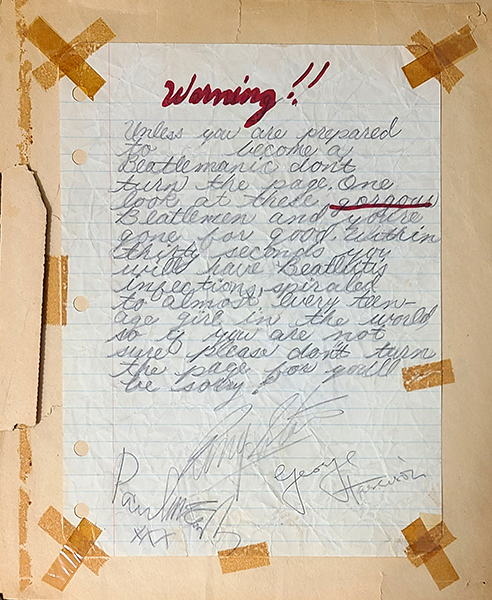

The Beatles’ first public concert was in Washington D.C. on February 11, 1964. This is a 114-page scrapbook created by 14-year-old Pamela Tames. Among all the diary-like notes, clippings and other souvenirs are several significant items.
Most importantly, her father, noted New York Times photographer George Tames, went to the press conference that day and got three of the Beatles’ autographs. Another photographer snapped a photo of Tames getting Paul to sign this scrapbook (George and Ringo are visible just behind Paul). Photos of Beatles actually signing a specific and identifiable autograph are extremely rare.
The scrapbook is filled with young Pamela’s euphoric notes and is a joy to read. It really captures the spirit of Beatlemania like few things can. This diary-like book is much more enlightening and entertaining than a scrapbook of mere news clippings.
Also in the scrapbook is Pamela’s ticket stub for the very first American concert. The Coliseum only held about 8,000 people, but of course nowhere near that many ticket stubs still exist, and many fans were handed back the “short stub” which only shows the seat number and date, not “The Beatles.”
Although Pamela’s father was not able to get John Lennon’s autograph, a period Lennon signature has recently been added to the scrapbook to complete the set.
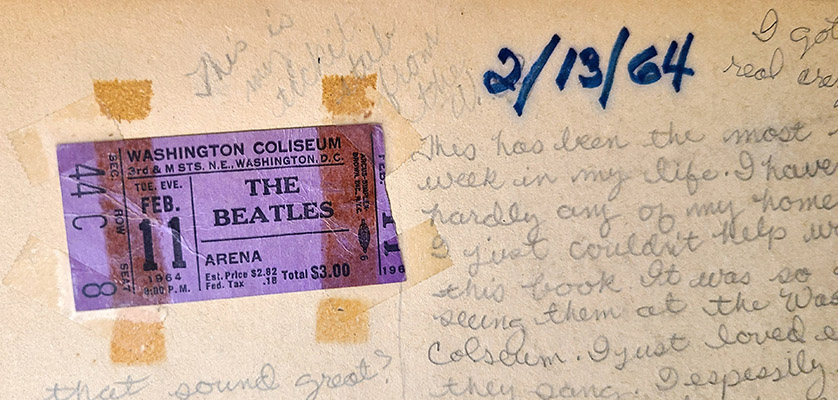
TICKET TO THE ED SULLIVAN SHOW – The most important musical broadcast in history.
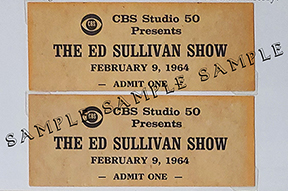
On February 9, 1964, variety show host Ed Sullivan gave the famous introduction: “…the city never has witnessed the excitement stirred by these youngsters from Liverpool, who call themselves The Beatles. Now tonight, you’re going to twice be entertained by them. Right now, and again in the second half of our show. Ladies and gentlemen, The Beatles!”
What followed was the most important music broadcast in television history. Rapturous screams greeted the band as they played “All My Lovin’,” “’Til There Was You” and “She Loves You” (Yeah, Yeah, Yeah). Later in the show, their second set included “I Saw Her Standing There” and the number one hit “I Want to Hold Your Hand.”
73.7 million people watched on television (60% of the total viewing public, and almost 40% of the entire U.S. population). 57 years later, it is still the 10th largest audience share for a non-sports broadcast in American television history.
The theater seated 728. Tickets were printed months before the show and mailed out long before the guests were announced. In mid-December 1963, The Beatles were announced for the February 9, 1964 show, and an additional 50,000 requests flooded in, including from Richard Nixon, Leonard Bernstein and Walter Cronkite (for their daughters, of course).
Tickets with a distinct design were hastily printed for V.I.P.’s, and the overflow audience members stood across the back of the theater. Ushers collected all tickets at the door and destroyed them. Because the theater was open seating, there was no need to return a ticket stub. Thus, none of the 728 regular tickets to The Beatles’ first performance have ever surfaced on the market. After 60+ years, only five unused V.I.P. tickets are known to exist.
The pair of numbered tickets shown above are accompanied by a CBS office memorandum that refers to the “special” or VIP tickets. They were auctioned in 2010 by the daughter of a woman who requested the tickets as a souvenir. The auction buyer was later convicted of murder and died in prison in 2018. His son sold the tickets in 2022, still framed as they were in 2010. The tickets have faded from years of display. They were originally bright orange.
TICKET TO THE FIRST CONCERT
OF THE “FAB FOUR”


The Beatles were not the “Fab Four” who rewrote popular music history until the lineup was completed when Ringo Starr joined the band on August 18, 1962. Their first concert was performed at Hulme Hall, Port Sunlight, England, across the Mersey River from their hometown of Liverpool. The hall was big enough for 450 people, but 500 tickets were sold to fans, none of whom knew what an historical event they were witnessing (many upset that Pete Best had been replaced). Thus, very few of the 500 tickets for that night were saved. The primary dealer in Beatles memorabilia in the UK recalls only two coming on the market.
Photos from our trip to Hulme Hall in 2017 show the outside of the building (the room the Beatles played was at the far, or righthand, side. The interior shot shows where The Beatles set up. While there used to be a stage at one end of the hall, it is gone now. However, I was told that because of the horticultural show that afternoon, the stage was covered with plants and flowers, and The Beatles had to set up on the dance floor itself. There are no known photos of the band playing that night.
TICKET TO THE ROYAL VARIETY PERFORMANCE – “Rattle Your Jewelry”
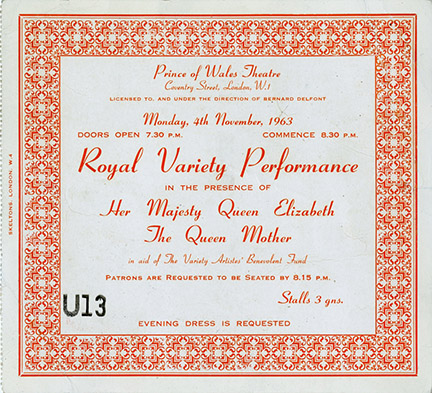

In performance at the Prince of Wales Theatre in London in the presence of Her Majesty Queen Elizabeth the Queen Mother and Princess Margaret, John Lennon made one of the most famous stage quips in music history.
Until the early 20th century the show was referred to as the Royal Command Performance, and was the most prestigious event of them all. After playing “From Me to You,” “She Loves You” and “’Til There was You,” Lennon made his rebellious introduction to “Twist and Shout.” “For our last number I’d like to ask your help. The people in the cheaper seats clap your hands. And the rest of you, if you’d just rattle your jewelry.”
Following his comment, Lennon’s face turned to a cheeky smile and offered a thumbs up to the royal box, to which the Queen Mother responded by raising her hand and smiling. The show was broadcast to over 21 million viewers a week later and will always be remembered for The Beatles creating one of those rare TV moments when the world seems to stop.
Evening dress was requested for these now very rare tickets, one in the “clapping zone” and one in the “jewelry rattling zone.” The orange floor seat (stalls as they call it in the UK) was 3 guineas ($93 today), and the blue tickets for the Dress Circle (balcony) were 10 and 20 guineas ($310 and $626 today).
1961 TICKET/MEMBERSHIP CARD FOR THE CAVERN CLUB – Brian Epstein meets The Beatles & Ringo’s 1st Paid Gig with The Beatles

The Beatles recorded their first record in 1961 in Hamburg, Germany, backing singer Tony Sheridan on “My Bonnie.” During that year they were finally gaining popularity in their hometown of Liverpool, playing small venues, including a dank basement club called The Cavern.
The key to the band’s continued advancement and becoming stars, it turns out, was music shop owner Brian Epstein. Brian prided himself on being able to supply any record his customers asked for. When Raymond Jones asked for a copy of “My Bonnie,” Brian set out to locate the record. His curiosity led him to see the band during their lunchtime performance at The Cavern Club on 9 November 1961.
Epstein and his assistant were allowed in without queuing and welcomed over the club’s PA system by DJ Bob Wooler who recalled, “They stood at the back of the crowd and heard John, Paul, George and Pete on stage, although they can’t have seen much. Nevertheless, Brian was bowled over by them.”
Epstein later recounted in his autobiography his first thoughts on seeing the group perform. “I was immediately struck by their music, their beat, and their sense of humor on stage – and, even afterwards, when I met them, I was struck again by their personal charm. And it was there that, really, it all started.” Shortly thereafter Brian became the manager of The Beatles, correctly predicting they would be “bigger than Elvis.”
Though The Cavern sometimes printed tickets for special events, there were no tickets printed for the lunchtime performance the day Brian first saw The Beatles. There would have been a long queue of fans hoping to get crammed in, each clutching their club membership card as a ticket. Membership cards from 1961 are scarce today.
The Beatles were quite familiar with Rory Storm and the Hurricanes’ drummer Ringo Starr, the bands having played the same venues many times. On the very cold Liverpool winter evening of 27 December 1961, The Beatles’ drummer Pete Best called in sick. Fortunately, the Hurricanes had the night off and Ringo was deputized to sit in, making this Ringo’s first paid gig with The Beatles. He would not become a permanent member until eight months later.
This membership card would admit its owner, Peter Law of Heswall, Wirall (about ten miles from the club) to see The Beatles on the historic day Brian Epstein saw them for the first time, and also to witness Ringo’s first paid gig with The Beatles – history in the making!
TICKET TO “SUNDAY NIGHT AT THE LONDON PALLADIUM” – “Beatlemania” is born.

In 1963, the London Palladium was the most famous theatre in the world. If you performed at the Palladium, you had “made it.” The Beatles’ popularity had been growing steadily and to increasingly frantic heights throughout 1963, but their appearance at the London Palladium on Sunday 13 October catapulted them from teen fanzines into the mainstream media.
Val Parnell’s “Sunday Night at The London Palladium” was a variety show that regularly drew huge British TV audiences. Competition to appear was fierce. Not only did the The Beatles make the cut, they topped the bill.
Their set began with “From Me to You,” “I’ll Get You” and “She Loves You.” Paul McCartney attempted to announce the finale, but was drowned out by the screams from the frenzied audience. Lennon told them to shut up, a gesture which was applauded by the older members of the audience. McCartney then asked them all to clap and stamp their feet to the rocking “Twist and Shout.”
The Beatles’ televised appearance was seen by an estimated 15 million people. Throughout the day the theatre was besieged by hundreds of Beatles fans. The next day, journalists wrote front-page stories about the hysteria. Although screaming girls were a regular occurrence around the Beatles by then, the national newspapers had virtually ignored The Beatles up to this point. The Palladium show changed that.
The group’s status as conquerors of Britain was confirmed, and it led directly to the coining of the term “Beatlemania” to describe the scenes of screaming and swooning fans. Beatlemania would dominate the press for years to come, and the Palladium show is widely accepted as its birth. Tickets are very scarce now.
TICKET TO THE BEATLES AT SHEA STADIUM – “The Mountain Top”
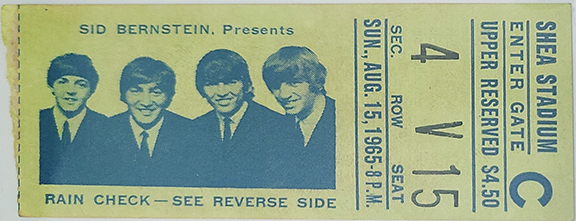
The stadium rock show was born on August 15th, 1965, when The Beatles headlined Shea Stadium, home of baseball’s New York Mets. It was by far the largest audience for a rock and roll concert up to that time and for years thereafter. Elvis Presley’s largest audience was just over 26,000 at the Cotton Bowl in Dallas [which held 75,000]. The Beatles more than doubled that and filled Shea Stadium’s 55,600 seats.
Tickets ($4.50, $5 and $5.65) sold out in 17 minutes. Two thousand ticketless fans were turned away at the gate. The band was flown by helicopter to the top of the World’s Fair Building next door, and driven to the stadium in an armored truck. Ed Sullivan, the man who brought The Beatles to America 18 months previously, announced to the screaming masses, “Now, ladies and gentlemen, honored by their country, decorated by their Queen, loved here in America, here are The Beatles!”
After the opening bands, The Beatles performed a 30-minute set of 12 songs: “Twist and Shout,” “She’s A Woman,” “I Feel Fine,” “Dizzy Miss Lizzy,” “Ticket to Ride,” “Everybody’s Trying to Be My Baby,” “Can’t Buy Me Love,” “Baby’s in Black,” “Act Naturally,” “A Hard Day’s Night,” “Help!” and “I’m Down.” John Lennon seemed to have the most fun at the concert, even channeling Jerry Lee Lewis by playing the organ with his elbows.
The landmark Beatles concert also set records for gross revenue. The box office raked in a staggering $304,000 in ticket sales, $160,000 of which went to The Beatles. It was the beginning of a new era in concert promotion.
Among those in attendance were Rolling Stones Mick Jagger and Keith Richards and a teenaged Meryl Streep. The performance was filmed for television, and remastered in 2016 for theatrical release in conjunction with the Ron Howard film Eight Days a Week – The Touring Years. Journalists have stated, hyperbolically, it was the most exciting 30 minutes in rock’n’roll history.
Lennon told promoter Sid Bernstein after The Beatles broke up, “You know, Sid, that concert in 1965 at Shea Stadium … I saw the top of the mountain that night.”
POSTER AND TICKETS FOR THE LAST BEATLES CONCERT
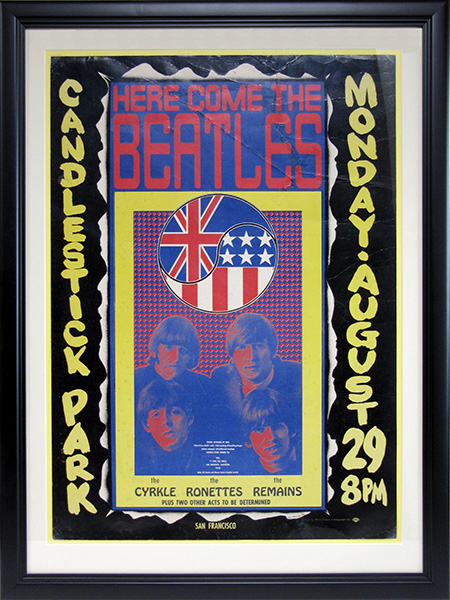
The Beatles’ concert on August 29, 1966, was their last public concert. Beatles concert posters from any of their shows are extremely rare, in part because before 1964 people just didn’t save them very often, and after 1964 there wasn’t much need for promoters to produce posters to advertise The Beatles because they did not need to go to that expense to sell tickets. In 1964 and 1965, Beatles concerts sold out almost immediately. By 1966 in America, there was some backlash against the Beatles and tickets didn’t sell quite as easily for the large stadium shows. Still, very few posters survive from the 1966 tour.
This particular poster was sold by a man who said he had purchased a number of things from the estate of the concert promoter, Tom “Big Daddy” Donohue, including this poster.
TICKETS TO THE LAST CONCERT
OF THE FAB FOUR
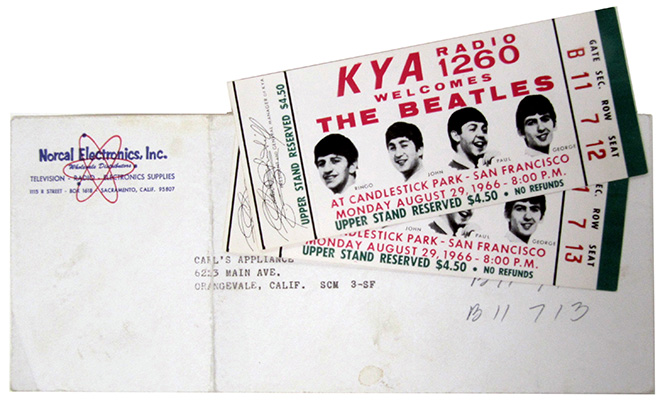
These consecutive, unused tickets were for The Beatles’ last concert. They belonged to a priest who said, “My uncle had an appliance shop in Orangevale, CA, called Carl’s TV and Appliance. He got these tickets from Norcal Electronics as a promotional item. They are still in [the Norcal] envelope but it is not dated [postmarked] because I think that he was handed them. In any event, he gave them to me because my two cousins were only like 12-13 years old. I had a date with a cheerleader, Lori Jensen, in the summer of 1966. When I went to pick her up (both of us just 17) her parents would not let her go. We lived in Sacramento and San Francisco was too far to go; plus those long-haired Beatles were too much for her parents. I was bummed so I didn’t go either. These tickets have been stored in my senior yearbook for the past 45 years.”
TICKET FOR THE HOLLYWOOD BOWL SHOW
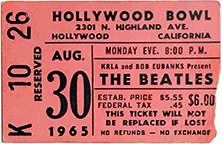
The Beatles’ first live recording released to stores was made from their shows at the Hollywood Bowl in 1964 and 1965. However, it wasn’t released until 1977. Seven of the twelve songs from the 30 August 1965 concert were released, five of them on the 1977 album, and two more on the 2016 reissue.
This particular ticket belonged to Michael Cappetta, a member of The Scuzzies singing group of siblings and cousins aged 11 to 15. They were a Los Angeles-based quintet that recorded the local hit single “Dave Hull The Hullabalooer” written by Michael’s sister, Suzie Cappetta, about Dave Hull, the top Los Angeles disc jockey at KRLA.
In an email to me in 2024, Cappetta recalled, “This ticket is one of five tickets personally handed out to the Scuzzies group members by Bob Eubanks. There was talk about having the Scuzzies come out on stage to introduce Dave Hull when he came out to say a few words about the Beatles. Bringing the Beatles to the Hollywood Bowl was all Bob Eubanks’ effort. He had never held or promoted a concert before, and it was all on his shoulders to make it a success. He needed capital to make it happen, so the only way he could do it was to mortgage his own home for a $20,000 bank loan (a lot of money in 1965). The final decision was up to Bob and his reasoning was that having the Scuzzies coming out to introduce Dave would be singling out one KRLA jock over all the others. I was 15 at the time, and I understood and think Bob made the right decision. And I’m sure that was the reason he decided to give us tickets, to at least be able to see the Beatles in concert.”
EARLY TICKET TO LITHERLAND TOWN HALL

One of The Beatles’ milestone performances was at Litherland Town Hall, Liverpool, on December 27, 1960. It is credited as the start of Beatlemania. They had just returned from Germany where their long hours on stage transformed them into a top band with a new and unique sound. Promoter Brian Kelly (Beekay) immediately booked as many dates as he could with The Beatles, including many more shows at Litherland Town Hall.
No tickets or stubs are believed to exist from that December show. The ticket above is the closest Litherland ticket you are likely to see, just seven weeks later on February 16, 1961. It is a rare, early souvenir, merely six months after they settled on the name The Beatles. Paul McCartney had started playing bass guitar just five weeks before (actually his beat-up Rosetti guitar with three strings clipped from a piano), though on this night Stuart Sutcliffe was playing bass, one of his last shows in Liverpool; it was a week before their first of almost 300 gigs at The Cavern Club; Brian Epstein would not discover them for another nine months; their first record would not be released until a year and a half later; and The Beatles’ debut in America was still three years away.
At this early stage, the band’s name was not even printed on tickets, and only a very few tickets exist today from any Beatles performance prior to this February date at Litherland Town Hall. As of this writing, I know of only one earlier ticket, identically styled by the same promoter for a January 19, 1961, show at Alexandra Hall.
SOUVENIR OF MEETING SIR PAUL McCARTNEY
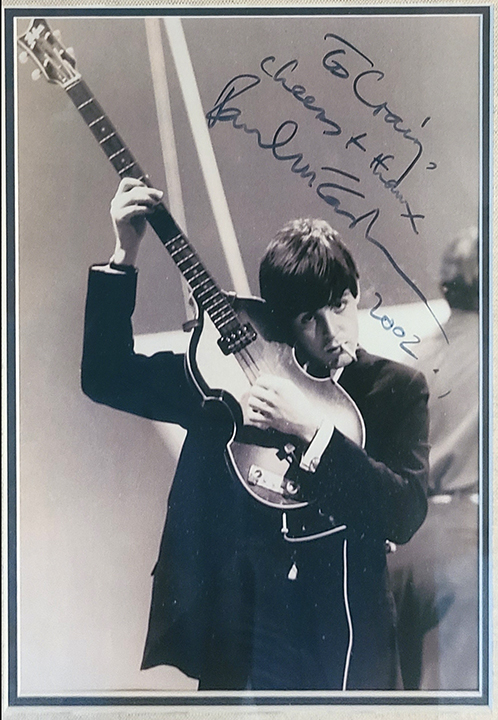
The autograph of Paul McCartney, obtained in Dallas on May 9, 2002. At the time, I was doing some work for a friend who ran a music industry magazine. I shouldn’t have, but I used that connection to arrange to meet Paul through his publicist. It took a few minutes of the publicist’s time, and about 60 seconds of Paul’s. No harm, no foul, right? (My friend had already met McCartney). I did ask permission from the publicist before asking for the autograph.
As a totally unexpected surprise and bonus, as I waited in the green room (for hours, by the way) in walked Sir George Martin, The Beatles’ record producer! Several of my Beatle-friends have met Paul, so I’m now a member of that club. None of them, however, got to meet George Martin, the man with the best claim to the title “The Fifth Beatle.”
In 1974 I attended George Harrison’s concert in Fort Worth, Texas. Fifty years later, a friend got me backstage to meet Ringo Starr. As a general rule, he doesn’t sign autographs anymore, but I did get a photo with him.
SOUVENIR OF MEETING SIR RINGO STARR
It took a long time to have an opportunity to meet Sir Ringo Starr, but I finally got my chance in June 2024.
THE “BUTCHER COVER”
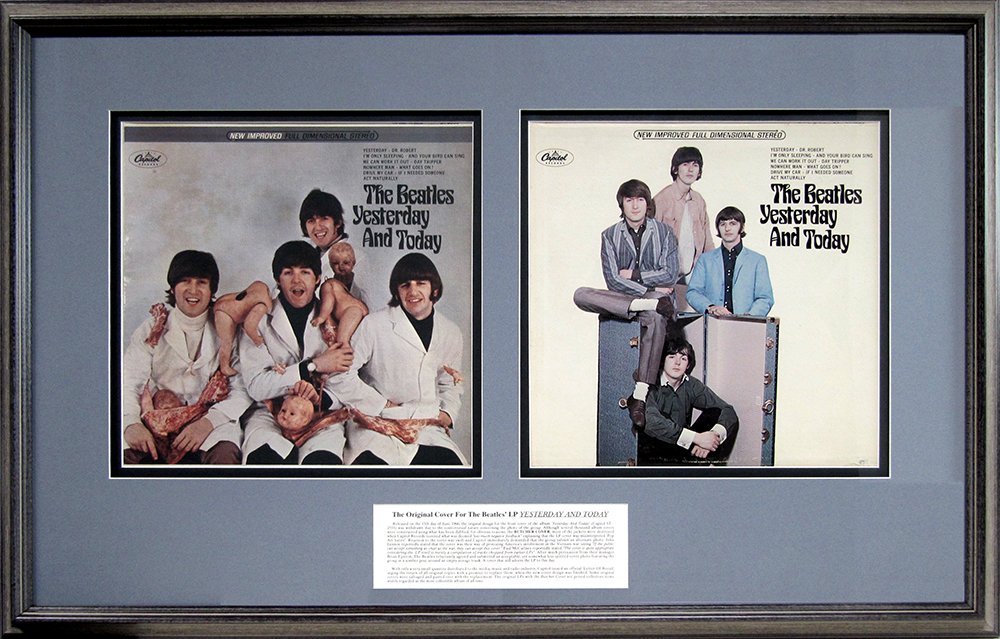
By 1966, just before their final concert tour, The Beatles had grown weary of press conferences, fan mail, touring and particularly photo sessions. The number of times they slogged through photo sessions between 1962 and 1966 probably cannot be counted.
One of, if not the, most famous and collectible record albums of all time (intended for mass release) is the famous “butcher cover” on The Beatles’ Yesterday… and Today album in 1966. The Beatles’ and their photographer’s attempt at pop art resulted in a photo of the cheerful, if not slightly maniacal-looking, Beatles in butcher’s smocks with pieces of baby dolls and raw meat strewn about. After an outcry from retailers that they would not put these on their shelves, Capitol Records initially lost money on a Beatles record because of the expense of having to recall them, destroy them or paste a new and dreadfully boring cover on top of the reused covers. The new cover showed the unhappy Beatles around an old steamer trunk. Thus, the butcher cover and the trunk cover.
A few butcher covers escaped the massive recall effort and the threats by Capitol to fire employees who tried to abscond with them. There is an irony born in that threat.
There are three types of butcher covers: original ( called “first state”), those with the replacement “trunk cover” pasted over the original (second state), and those with the pasteover cover removed to reveal the original (third state). First state butcher covers are very rare, and those that are still sealed in the original shrink wrap plastic are the most rare and valuable, there likely being less than 40 existing in the world (some experts say less than 30). The most highly coveted of the sealed butcher covers are those which came from Alan Livingston, president of Capitol Records, who was persuaded to keep a box of 25 butcher cover LP’s. The irony is that Livingston himself issued the edict of punishment for any employee disregarding the recall.
Below is one of the 25 “Livingston” butcher covers. This particular copy was gifted by Livingston to a colleague in 1977 while working at 20th Century Fox, according to an interoffice memorandum documenting the gift.

THE BEATLES’ FIRST AMERICAN RECORD
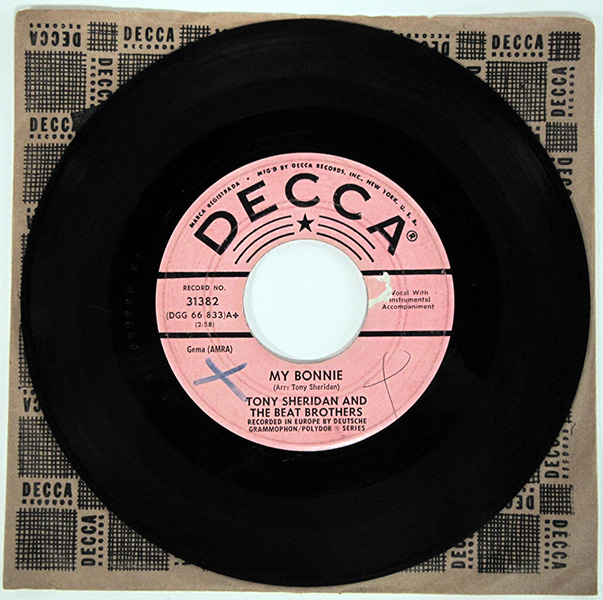
From mid-1960 to the end of 1962, The Beatles were hired several times to play nightclubs in Hamburg, Germany. The Hamburg residencies were the most important in their career – like graduate school for the young musicians. They learned to put on high-energy shows and vastly increase their repertoire in order to attract bar patrons off the street and into the club. They honed their chops, built their reputation and also recorded in Hamburg with another British musician, Tony Sheridan, as his backing group. The resulting record was brought to Brian Epstein’s attention, and the rest is history.
You’ll notice The Beatles are credited on the record as “The Beat Brothers.” The record was of course originally released in Germany (their very first commercially-released record), and “Beatles” apparently sounds a lot like the German slang for penis, so the producer changed their name to Beat Brothers.
Almost a year before The Beatles came to America, Decca Records released the record in the U.S. on 23 April 1962. Few were sold. Shown above is the promotional version of their first American record. Promotional copies were sent to radio stations and reviewers, and were made in limited numbers.
ONE OF THE LAST AUTOGRAPHS
SIGNED BY JOHN LENNON

John Lennon’s Double Fantasy album was released on 17 November 1980. Double Fantasy album covers signed by John Lennon are very rare, with approximately twelve coming to market in forty years. A photo taken in John’s office on 21 November 1980 shows him signing eight to eleven Double Fantasy albums. Just 17 days later, he was murdered. In the short amount of time he had to do so, John signed these few albums for close friends, colleagues and studio employees.
This Double Fantasy album cover was autographed by John, “To Karen, love John Lennon.” Additionally, he has drawn caricatures of himself and Yoko, who has also signed this cover, directly beneath the caricatures. The Karen to whom John inscribed this album worked in the studio, so this may be one of the albums in the photo below.
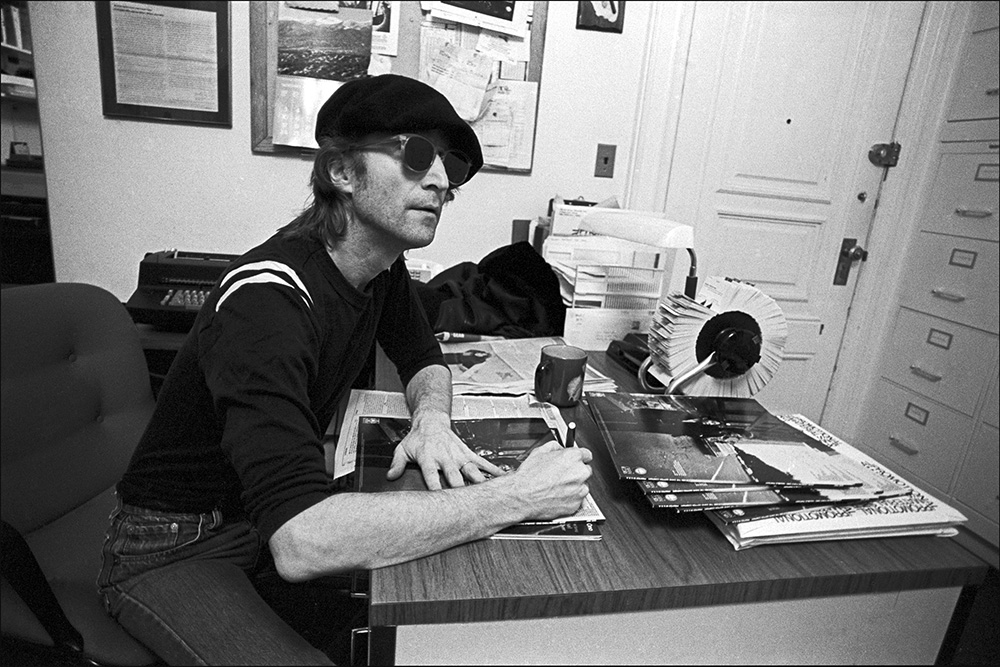
OTHER BEATLES ITEMS
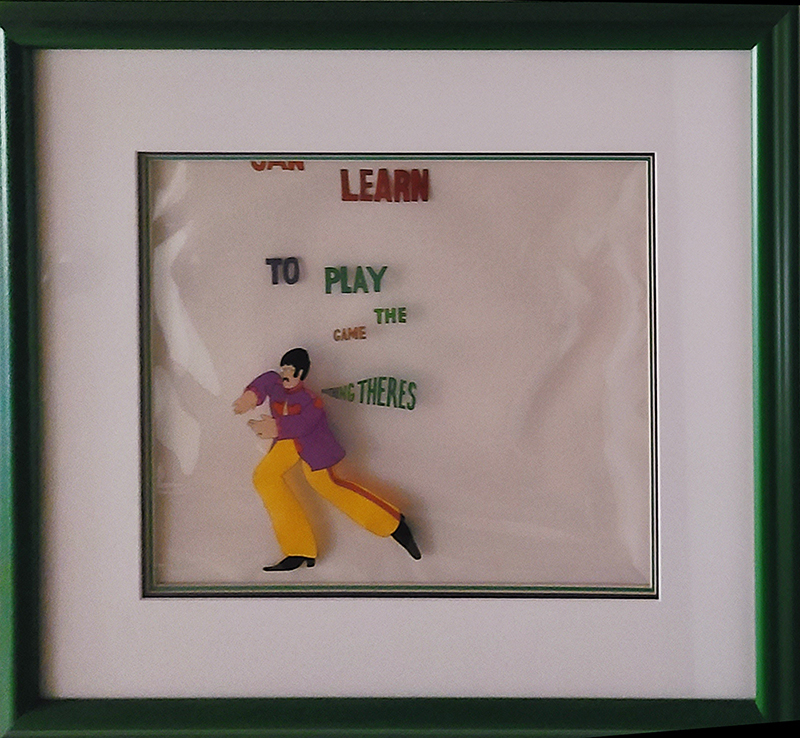
John Lennon original animation cel from the movie Yellow Submarine in 1968. A multi-cel setup from the song “All You Need is Love.”
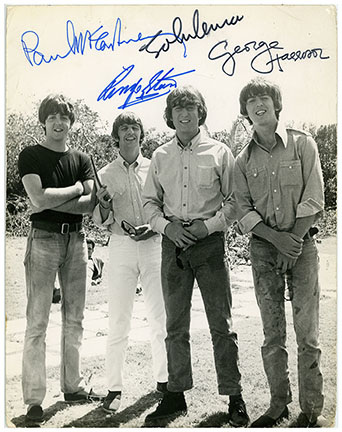

I like the above pictured set of autographs because the signatures are very bold and high contrast in the light area of the photo. It shows The Beatles in the Bahamas during the filming of the movie “HELP!” in 1965. This photo was one of several signed and given to the cast and crew, and this one was for Frank Elliott, an assistant camera operator and also an extra in the movie. Frank is shown above in costume posing with George Harrison.

Original custom artwork by Ron Campbell, the director of The Beatles TV cartoon series in the 1960’s. A gift from friends for our wedding in 2013.
“THERE ARE PLACES I REMEMBER …”
FAB FOUR BRICKS

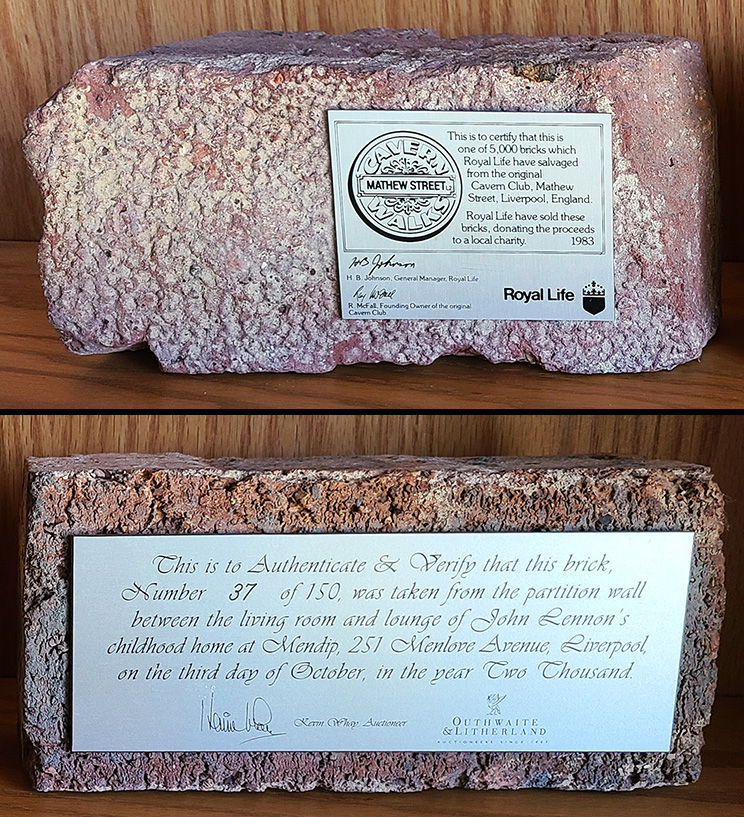
An unusual thing to collect – bricks. You know the old saying, “If walls could talk.”
The Beatles may have been the first to be the subject of pop culture collectible bricks in 1983 with the marketing of the bricks which formed the famous Cavern Club in Liverpool. The Beatles performed there almost 300 times from 1961-1963. The club was later destroyed, and 5,000 bricks were salvaged and sold.
Another brick is from John Lennon’s home, 251 Menlove Avenue, Liverpool (called “Mendips”). He lived there from 1945 until 1963 when The Beatles moved to London to begin their recording career. Only 150 bricks were salvaged from the removal of part of an interior wall for a film project. The house is now owned by the National Trust as a museum and protected building. There will never be any more souvenirs like this from John Lennon’s house.
A mansion on property known as Strawberry Field, Liverpool, where Lennon often played, was immortalized in the song “Strawberry Fields Forever.” The mansion was demolished in 1973. 2500 bricks were salvaged.
Studio 2, EMI Abbey Road Studios, was the site of almost all The Beatles’ recordings, and is the most famous studio in the world. Others who have recorded there include Pink Floyd, Oasis, Adele and many others. 210 bricks were salvaged when the studio was slightly altered in 2016.
1962 YEAR OF ACHIEVEMENT HANDBILL – AUTOGRAPHED
This poster was enlarged and reprinted from the December 19, 1962, issue of the Liverpool-based music paper Mersey Beat. The original ad was taken out by Brian Epstein proudly listing the group’s achievements from the first year of his management, including: Won Mersey Beat Popularity Poll (2nd Year); E.M.I. Recording Contract; Four B.B.C. Broadcasts; Two Hamburg Engagements; and Entered the Top 50 Within Two Days of “Love Me Do” Release.
He also lists some of the upcoming events for 1963: the release of “Please Please Me”, a Scottish Tour in January, a Helen Shapiro Tour in February, the list ending with “And Who Knows!” The photos on this poster were taken in November 1962 by Astrid Kirchherr in Hamburg.
Each Beatle signed next to their image, adding X’s for kisses to a fan named Wendy Smith who worked in a Nottingham hairdressing shop when a Beatles rep asked if the flyer could be displayed. She took it to the concert at the city’s Elizabethan Ballroom on 7 March 1963. She was invited backstage to meet the Beatles who signed her handbill.
These handbills were printed on extremely thin paper and were not meant to last. They were used as handbills and placed on shop counters and windows. Few survived, and even fewer that were signed (I know of only two). This is the only item in my collection that I have had professionally restored to remove cellophane tape stains and some paper loss. It looks fabulous now.

TICKETS TO THE 4 FILM PREMIERES
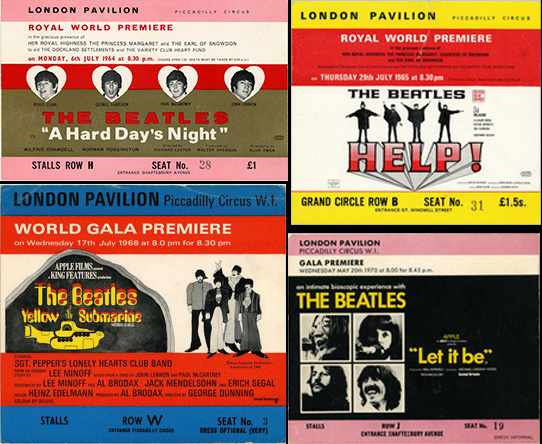
The gala premieres of The Beatles’ four theater films all took place at the London Pavilion in Piccadilly Circus, London. The area streets were filled with fans on each occasion (12,000 for A Hard Day’s Night, 10,000 for HELP!), hoping to catch a glimpse of the group entering or exiting the theatre.
The Pavilion only seated 1209: 716 on the main floor (what the British call the stalls), 242 in the grand circle and 251 in the balcony. Princess Margaret and Lord Snowden attended the first two premieres, thus they are referred to on the tickets as Royal Premieres.
The Beatles attended the first three premieres, but had announced the breakup of the group about a month prior to the gala for Let it Be in 1970, and did not attend, though many other celebrities did. A fifth film produced during their time as a band was Magical Mystery Tour, broadcast on BBC-TV and not premiered in a theater. Instead, a private party was organized to celebrate the film’s completion.
A Hard Day’s Night and HELP!, in particular, remain highly regarded as influential musicals and precursors to the rise of music videos and MTV.
The Sheet Music That Got The Beatles a Recording Contract

Brian Epstein first saw The Beatles at the Cavern Club in Liverpool on November 9, 1961, and immediately asked to manage them. His primary goal was to get them a recording contract. If he failed, it is very likely the group would have split up. On January 1, 1962, Brian arranged an audition with one of the largest record companies in Britain, Decca Records. They rejected The Beatles, famously telling Brian that guitar groups are on the way out! However, Brian came away from the event with a tape of fifteen songs, three of them original compositions by John Lennon and Paul McCartney.
Brian hit up every major record company in London, and all of them declined to sign The Beatles, including EMI. In February 1962, Brian went into the HMV record store to have some of the songs on the tape cut to 78rpm acetates. Brian and the clerk talked about three of the songs being original compositions by Lennon and McCartney. The man thought the songs were good and when Brian said the young songwriters did not have a publisher yet, he suggested that Brian talk with Sid Coleman of Ardmore & Beechwood music publishers, whose offices were on the fourth floor of the same building.
Coleman also thought the songs were good and offered a publishing contract. Brian was reluctant to sign it because he wanted The Beatles to record the songs, and the publisher would merely give the songs to another artist. He promised Coleman that if he could help get them a recording contact, Brian would sign the publishing deal with Ardmore & Beechwood.
One of Coelman’s employees, Kim Bennett, began to pester EMI to sign The Beatles. EMI’s Len Wood again declined, and rejected them a third time even after Ardmore & Beechwood offered to pay for the cost of the recordings themselves. But as fate would have it, as it always does, in a meeting with Sid Coleman in April 1962, Wood finally agreed to let Ardmore & Beechwood pay the cost of recording The Beatles so they could get the publishing deal. Wood, still not believing The Beatles were worth the trouble, and being upset with EMI producer George Martin for a couple of reasons, instructed Martin to sign and produce the long-haired group.
After EMI and every other major label in London had turned down The Beatles, it was only the persistence of Ardmore & Beechwood to obtain the publishing rights for Lennon-McCartney original compositions that finally led to The Beatles getting the essential recording contract to justify the band’s continued existence. Although the music publishing company was crucial to the success of The Beatles, they are often overlooked in historical accounts.
The first original composition released by The Beatles was “Love Me Do.” Its sheet music was published by Ardmore & Beechwood, without whom the world might not have known the greatest band in history.
The First Record Released by
John, Paul, George & Ringo
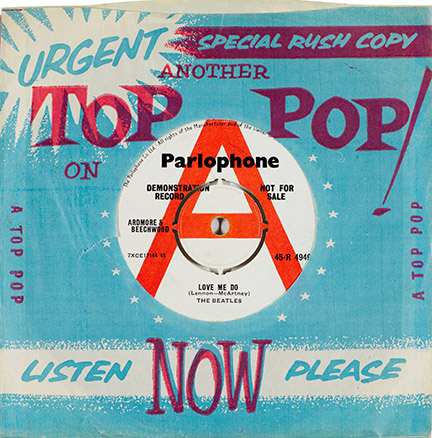
While we are talking about “Love Me Do” …
The very rare Parlophone A-label demonstration copy of “Love Me Do” / “P.S. I Love You” is the first record by The Beatles, comprised of John Lennon, Paul McCartney, George Harrison and their new drummer, Ringo Starr. It was produced in mid- to late September 1962 before the commercial release on October 5, 1962. The white labels had a distinctive red “A” on one side, designating the primary song being promoted. Advance copies were pressed before the commercial copies and sent to reviewers and radio stations. If the reaction was poor, fewer commercial copies would be pressed when the record was released.
Unfortunately, when Paul saw the advance copy of his first record, he was disappointed to see his surname misspelled as “McArtney.” It was corrected before the commercial copies were pressed.
This is one of only 250 demonstration copies produced, and it is still accompanied by its original “Urgent, Special Rush Copy, TOP POP!” paper sleeve urging the recipient to “Listen NOW please.” The A-label “Love Me Do” promotional records are among the most sought-after records among collectors.
The two songs on the record were composed by Lennon and McCartney, and were among those on a tape being played by manager Brian Epstein in early 1962 to anyone in the business he could get to listen, hoping to get The Beatles a recording contract. Music publisher Ardmore & Beechwood saw the potential in the songwriting by Lennon and McCartney, and, determined to obtain the publishing rights, it was Ardmore & Beechwood’s persistence that led EMI to reverse their denial of a record deal for The Beatles.
This version of “Love Me Do” was recorded on September 4, 1962. It reached #17 on the UK Singles Chart in 1962, and topped the Billboard Hot 100 in the United States on May 30, 1964. This initial pressing of the single features Ringo Starr on drums, while another version with Andy White on drums was used on the Beatles’ debut album, Please Please Me. This promotional record launched the group soon to be know as the Fab Four.
More to come …
